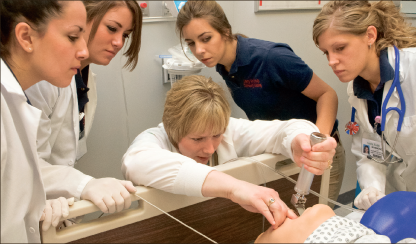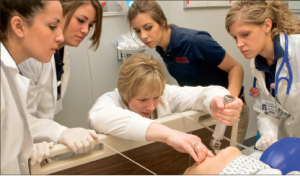Nursing program remains rigorous

Liberty University’s nursing department is well known for the intense program it uses to bring out the full potential of its students. While the entire program is rigorous, junior year is one of the toughest obstacles the students face.

Training — Nursing students practice life-saving techniques on a mannequin in the lab. Photo credit: Jordan Crossingham, Promotional Publication
One of the most difficult aspects of this particular year is the class known simply as Med. Surg., officially known as Strategies for Adult Heath Care: Family and Health. This year-long class includes typical exams, as well as weekly clinicals that students are required to attend at the local hospital. The clinicals themselves are approximately eight hours each, according to junior Matthew Gilbert.
Students are assigned to specific floors and units during each clinical they attend. This gives students the opportunity to determine which unit benefits the most from their strengths and where they can most apply themselves, according to Gilbert.
“My favorite has been PCU, the progressive cardiac unit,” Gilbert said. “It’s interesting to see how the heart works. It’s such an interesting organ and it’s responsible for so much. It’s like a cascade, one little thing goes wrong and it goes from there.”
The opportunities that the students are able to experience during clinicals are invaluable, according to Assistant Professor of Nursing Emilee Harker.
Students begin working with the patients as soon as they begin clinicals. The beginning of the year is the most difficult because students do not know what to expect. The work becomes easier as the year progresses, but transferring knowledge from the books into real life situations is difficult at first, according to Gilbert.
“It’s just a completely different databank of information,” Gilbert said.
While this portion of the assignment is long, it is not the only task involved in clinicals. Also involved is pre-work and post-work.
Pre-work, more commonly known as a profile, includes typing up drug names, side effects, why a patient is on a certain drug and other important information. Students are required to come up with interventions based on their knowledge of the situation, according to Gilbert.
The exams for this class are similar to this in that they require the students to assess specific situations. With only three or four factual questions, the rest of the 50 multiple choice question exams are composed of scenarios. Students have to choose the answer which they feel should be their first response to the situation, according to Gilbert.
“It’s not like a black and white question,” Gilbert said.
Questions are designed this way in order to push the students to consider how they would respond in a real life situation.
“It’s more of an application of the material,” Harker said. “We stretch our students to critically think more in their junior year based on what they’ve learned both in class and at the bed side.”
The nursing program grading scale is more difficult when compared to the other university programs. The department uses a seven point grading scale and considers anything below a C to be failing. This adds to the challenge of the nursing program, according to assistant professor if nursing Bo Kail.
“It gets easier as the junior year goes on. Usually it’s that first semester, the fall, that is the most challenging, and then in the spring it gets easier. Their course load remains challenging, but students learn how to manage their time and better understand the disease processes,” Harker said.
In addition to the work surrounding Med. Surg., students also have other classes to focus on, such as Pharmacology. The exams for this class are difficult, with questions requiring intense memorization, according to Gilbert.
Students, according to Jerry Harvey, assistant professor of nursing, must take a six hour course their first and second semesters in the program, and then complete three hours of lecture each week and eight hours of clinical.
“Each semester they have very nursing, science heavy courses that they’re taking,” Harvey said.
Kail, Harker and Gilbert all recommend that nursing students who are approaching their junior year start off with the intention of putting their whole heart into it. They said that even though the work is time consuming, it is possible to pass.
“There’s no reason to fail junior year if you put the time into it,” Gilbert said. “Study a few hours a day, just keep on top of it.”
It is important to keep the end result in mind when working through this tough year in the program. The chance to work with people and help them in their time of need is the end goal. The work prior to obtaining this job is extremely challenging, according to Kail.
“Nursing as a profession is one of the most respected positions in the country,” Kail said. “Doctors treat disease, nurses treat the patient. We’re the one at the bed side noticing the subtle changes before they turn into major changes.”
The work that these students put into their junior year will benefit not only their future careers, but also the people whose lives they touch in their line of work, according to Harker.
“They’re amazing students, and we’re so proud of them,” Harker said.
